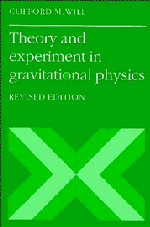Book contents
- Frontmatter
- Contents
- Preface to Revised Edition
- Preface to First Edition
- 1 Introduction
- 2 The Einstein Equivalence Principle and the Foundations of Gravitation Theory
- 3 Gravitation as a Geometric Phenomenon
- 4 The Parametrized Post-Newtonian Formalism
- 5 Post-Newtonian Limits of Alternative Metric Theories of Gravity
- 6 Equations of Motion in the PPN Formalism
- 7 The Classical Tests
- 8 Tests of the Strong Equivalence Principle
- 9 Other Tests of Post-Newtonian Gravity
- 10 Gravitational Radiation as a Tool for Testing Relativistic Gravity
- 11 Structure and Motion of Compact Objects in Alternative Theories of Gravity
- 12 The Binary Pulsar
- 13 Cosmological Tests
- 14 An Update
- References
- References to Chapter 14
- Index
9 - Other Tests of Post-Newtonian Gravity
Published online by Cambridge University Press: 04 April 2011
- Frontmatter
- Contents
- Preface to Revised Edition
- Preface to First Edition
- 1 Introduction
- 2 The Einstein Equivalence Principle and the Foundations of Gravitation Theory
- 3 Gravitation as a Geometric Phenomenon
- 4 The Parametrized Post-Newtonian Formalism
- 5 Post-Newtonian Limits of Alternative Metric Theories of Gravity
- 6 Equations of Motion in the PPN Formalism
- 7 The Classical Tests
- 8 Tests of the Strong Equivalence Principle
- 9 Other Tests of Post-Newtonian Gravity
- 10 Gravitational Radiation as a Tool for Testing Relativistic Gravity
- 11 Structure and Motion of Compact Objects in Alternative Theories of Gravity
- 12 The Binary Pulsar
- 13 Cosmological Tests
- 14 An Update
- References
- References to Chapter 14
- Index
Summary
There remains a number of tests of post-Newtonian gravitational effects that do not fit into either of the two categories, classical tests or tests of SEP. These include the gyroscope experiment (Section 9.1), laboratory experiments (Section 9.2), and tests of post-Newtonian conservation laws (Section 9.3). Some of these experiments provide limits on PPN parameters, in particular the conservation-law parameters ζ1, ζ>2, ζ3, ζ4, that were not constrained (or that were constrained only indirectly) by the classical tests and by tests of SEP. Such experiments provide new information about the nature of post-Newtonian gravity. Others, however, such as the gyroscope experiment and some laboratory experiments, all yet to be performed, determine values for PPN parameters already constrained by the experiments discussed in Chapters 7 and 8. In some cases, the prior constraints on the parameters are tighter than the best limit these experiments could hope to achieve. Nevertheless, it is important to carry out such experiments, for the following reasons:
(i) They provide independent, though potentially weaker, checks of the values of the PPN parameters, and thereby independent tests of gravitation theory. They are independent in the sense that the physical mechanism responsible for the effect being measured may be completely different than the mechanism that led to the prior limit on the PPN parameters. An example is the gyroscope test of the Lense–Thirring effect, the dragging of inertial frames produced purely by the rotation of the Earth. It is not a preferred-frame effect, yet it depends upon the parameter α1.
- Type
- Chapter
- Information
- Theory and Experiment in Gravitational Physics , pp. 207 - 220Publisher: Cambridge University PressPrint publication year: 1993

